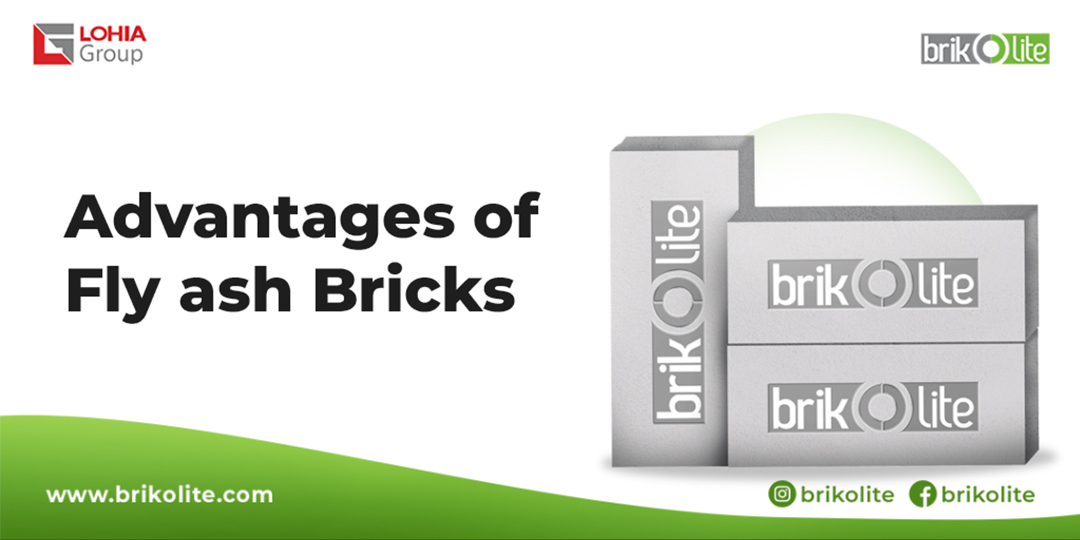Introduction:
Construction of any kind of structure demands the application of solid building materials. As a constructor or builder it’s compulsory to have a clear understanding of the ingredients that make up for a compact construction substance. Thus, choosing the type of bricks that would produce the finest possible result is essential for a sturdy structure. And, knowing well the advantages of fly ash bricks, professional engineers always go for ash bricks.
So, what are fly ash bricks?
Fly ash bricks, unlike the regular red clay bricks, contribute to preventing soil erosion. Their building composition consists of fly ash, stone dust, and lime. And it is these elements that add up a significant part towards a healthy soil environment.
The manufacturing process involves the inclusion of thermal plant remains. And they include coal ash, river sand, and stone particles. Also, the whole activity incorporates the replacement of 10 to 20% of real cement. Then, they are put together to give the shape of a rectangle that resembles a clay brick.
It’s history and invention
Since the dawn of time, the majority of homes and industries have contributed waste coal dust. In the nineteenth century, “decomposers” would collect coal ash and carry it to nearby brickworks, where it would be combined with clay.
Even though the term “fly ash” was first used in 1930, it wasn’t recognized as such until 1937. Fly ash was first used in 1948 during the construction of the Hungry Horse Dam, as recorded in history.
If we look at how these advantages of fly ash bricks have evolved over time, Mr. Henry Liu deserves praise. Mr. Henry Liu, born in 1939, paved the way for a miracle by converting the poisonous residue of burning coal into bricks that look and function equal to the traditional ones built of clay. It is crucial to mention here that Liu wasn’t the first to look into the possibility of using fly ash into bricks. Nevertheless, he developed a manufacturing process that made the bricks economically possible in his latter 60s.
Read along the following points to explore the advantages of fly ash bricks.
Appealing to the eye
Fly ash bricks have a particularly appealing look. Inevitably, that results due to their consistent size, enticing shade that resembles that of a cement, and polished texture. Additionally, their consistent dimensions lower the amount of mortar required for walls and plastering by around 40–50%.
Over and above that plaster of Paris (sometimes referred to as gypsum plaster) can also be applied without already curing the plaster.
Resilience or durability
One major reason for the increasing use of fly ash bricks is primarily due to their strong resilience attributes. Moreover, their durability or sturdiness has no bearing on their environmental suitability.
Moisture Resistance
Fly ash bricks retain moisture at a rate of only 6–12%, in contrast to the 20–25% claimed for handmade clay bricks. This aids in reducing the walls’ moisture content.
Functionality or applicability
The applicability of fly ash bricks answers the question of “Is fly ash bricks good for construction? It is because owing to their minimal weight, these bricks are ideal for multi-story complexes. And undoubtedly low weight results in reducing the load bearing on buildings.
Heat Response
One of the many benefits of fly ash bricks is their excellent response to temperature and heat. The heat capacity for fly ash bricks ranges from 0.90 to 1.05 W/m2. Thus, they efficiently help to heat your home during the chilly winter and cool it during the heated summer because of this exceptional factor. And this occurs all because fly ash and lime undergo a pozzolanic reaction that generates less heat.
Prevents Soil Erosion
Contrary to those customary red bricks, which demand a staggering amount of clay, fly ash bricks don’t involve clay in their composition. And these advantages of fly ash bricks make them stand out as a particularly green building material. And for this reason, it has been labeled as a “white” product because there is no pollution or ecological crisis.
Compressive Strength or Structural Capability
Fly ash bricks exhibit a compressive strength of around 9.00 N/mm2, compared to 3.50 N/mm2 for handmade clay bricks. As a result, it prevents cracks and waste during shipping and handling. And beyond a doubt, it is one of the prime reasons behind the increasing number of uses of fly ash bricks.
To explore more on the advantages of fly ash bricks, let us dip into the statement, ‘Fly ash bricks vs. red bricks which is better?’
It’s the staggering variation between the innovative fly ash bricks and the customary red bricks that makes the former a phenomenal building material. Indeed, it’s its building composition and the properties that serve to meet the need.
Let’s take a glimpse on it now:
Plastering
Unlike the red bricks which require plastering at any cost to make it more appealing, the fly ash bricks provide an easy and time-saving process. In other words, fly ash bricks demand no plastering. And, it for sure is one of the weighty advantages of fly ash bricks.
Weight
While red bricks call for manpower to carry them in the process due to their hefty load, fly ash bricks are ultra-light.
Pre-soaking
Red bricks need to be pre-soaked in water prior to their usage, whereas fly ash bricks are less permeable and don’t need pre-soaking.
Strength
The traditional bricks are a little less robust in comparison to the innovative fly ash bricks, which are extra solid and resilient.
Environmental Consequences
Traditional bricks are environmentally harmful because they require clay, which causes soil erosion and contributes to air pollution from chimneys. Whereas fly ash bricks are created from trash and waste products, they are therefore environmentally sustainable.
Cost
Fly ash bricks cost 30% cheaper than clay bricks, on average. Thus, leading to the increasing number in regards to the uses of fly ash bricks.
Aesthetic appeal
As the colour of the clay bricks depends on the shade of the soil, the colour doesn’t remain constant. While fly ash bricks with standardized hues display a more appealing semblance.
Sizes
Given that red bricks are handcrafted, red bricks have random shapes and dimensions. As for fly ash bricks are manufactured in casts, hence their shape is continuously identical.
Compressive Strength
Clay brick provides a compressive stiffness of approx 35 kg/cm2. While, the compressive capacity of fly ash brick is approximately 100 kg/cm2.
Application of mortar
The demand for mortar is considerable for clay bricks. But, the use of mortar is far less than clay bricks when it comes to fly ash bricks for building structures.
Conclusion
As discussed in the above points on the advantages of fly ash bricks, Brikolite AAC blocks feature many advantageous properties. And there arises no question as to why the uses of fly ash bricks are mushrooming over the years. These bricks are easy to attain and quite effective to install. Hence, using Brikolite AAC bricks in your construction procedure would be the wisest move. And if you have any inquiries regarding our services, please don’t bother to approach us








Hi, this is a comment.
To get started with moderating, editing, and deleting comments, please visit the Comments screen in the dashboard.
Commenter avatars come from Gravatar.